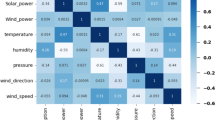Abstract
Accurate prediction of solar power generation is crucial for optimizing the integration of renewable energy into the grid and promoting its efficient use. In this study, we compare the performance of three machine learning techniques - Random Forest Regression, Gradient Boosting Machine, and Artificial Neural Network - for predicting hourly solar power generation in a region in Germany, using a dataset from the Open Power System Data website. The models were evaluated based on their R-squared value, Mean Absolute Error (MAE), and Root Mean Squared Error (RMSE). Our findings indicate that Random Forest Regression outperforms the other techniques, demonstrating its robustness to noise, effective feature selection, and ensemble learning approach. The results have practical implications for grid management, energy storage planning, investment decisions, and policy development in the renewable energy sector. We acknowledge the limitations of our study, such as the limited dataset and basic feature engineering techniques and suggest future research directions to further improve solar power prediction accuracy, including exploring additional variables, advanced feature engineering methods, and alternative or hybrid models.
Access this chapter
Tax calculation will be finalised at checkout
Purchases are for personal use only
Similar content being viewed by others
References
Solangi, K.H., Islam, M.R., Saidur, R., Rahim, N.A., Fayaz, H.: A review on global solar energy policy. Renew. Sustain. Energy Rev. 15(4), 2149–2163 (2011)
Ahmed, R., Sreeram, V., Mishra, Y., Arif, M.D.: A review and evaluation of the state-of-the-art in PV solar power forecasting: techniques and optimization. Renew. Sustain. Energy Rev. 124, 109792 (2020)
O’Leary, D., Kubby, J.: Feature selection and ANN solar power prediction. J. Renew. Energy 2017 (2017)
Pang, Z., Niu, F., O’Neill, Z.: Solar radiation prediction using recurrent neural network and artificial neural network: a case study with comparisons. Renew. Energy 156, 279–289 (2020). https://doi.org/10.1016/J.RENENE.2020.04.042
Izgi, E., Öztopal, A., Yerli, B., Kaymak, M.K., Şahin, A.D.: Short–mid-term solar power prediction by using artificial neural networks. Sol. Energy 86(2), 725–733 (2012)
Jang, H.S., Bae, K.Y., Park, H.-S., Sung, D.K.: Solar power prediction based on satellite images and support vector machine. IEEE Trans. Sustain. Energy 7(3), 1255–1263 (2016)
Buwei, W., Jianfeng, C., Bo, W., Shuanglei, F.: A solar power prediction using support vector machines based on multi-source data fusion. In: 2018 International Conference on Power System Technology (POWERCON), IEEE, 2018, pp. 4573–4577
Abuella, M., Chowdhury, B.: Random forest ensemble of support vector regression models for solar power forecasting. In: 2017 IEEE Power & Energy Society Innovative Smart Grid Technologies Conference (ISGT), IEEE, 2017, pp. 1–5
Khalyasmaa, A., et al.: Prediction of solar power generation based on random forest regressor model. In: 2019 International Multi-Conference on Engineering, Computer and Information Sciences (SIBIRCON), IEEE, 2019, pp. 780–785
Wang, J., Li, P., Ran, R., Che, Y., Zhou, Y.: A short-term photovoltaic power prediction model based on the gradient boost decision tree. Appl. Sci. 8(5), 689 (2018)
Persson, C., Bacher, P., Shiga, T., Madsen, H.: Multi-site solar power forecasting using gradient boosted regression trees. Sol. Energy 150, 423–436 (2017)
Wu, Y.-K., Huang, C.-L., Phan, Q.-T., Li, Y.-Y.: Completed review of various solar power forecasting techniques considering different viewpoints. Energies (Basel) 15(9), 3320 (2022)
Gao, B., Huang, X., Shi, J., Tai, Y., Zhang, J.: Hourly forecasting of solar irradiance based on CEEMDAN and multi-strategy CNN-LSTM neural networks. Renew. Energy 162, 1665–1683 (2020)
Al-Hajj, R., Assi, A., Fouad, M.M.: Stacking-based ensemble of support vector regressors for one-day ahead solar irradiance prediction. In: 2019 8th International Conference on Renewable Energy Research and Applications (ICRERA), IEEE, 2019, pp. 428–433
Amarasinghe, P., Abeygunawardana, N.S., Jayasekara, T.N., Edirisinghe, E., Abeygunawardane, S.K.: Ensemble models for solar power forecasting—a weather classification approach. AIMS Energy 8(2), 252–271 (2020)
OPSD.: Open Power System Data (2023). https://open-power-system-data.org/. Accessed 08 Jun 2023
Elavarasan, D., Vincent, P.M.D.R.: A reinforced random forest model for enhanced crop yield prediction by integrating agrarian parameters. J. Ambient. Intell. Humaniz. Comput. 1–14 (2021)
Davagdorj, K., Lee, J.S., Pham, V.H., Ryu, K.H.: A comparative analysis of machine learning methods for class imbalance in a smoking cessation intervention. Appl. Sci. 10(9), 3307 (2020)
Gupta, N.: Artificial neural network. Netw. Complex Syst. 3(1), 24–28 (2013)
Author information
Authors and Affiliations
Corresponding author
Editor information
Editors and Affiliations
Rights and permissions
Copyright information
© 2023 The Author(s), under exclusive license to Springer Nature Singapore Pte Ltd.
About this paper
Cite this paper
Murdan, A.P., Armoogum, V. (2023). Comparing Machine Learning Techniques for Hourly Solar Power Generation Prediction. In: Lu, J., et al. Proceedings of the 9th IRC Conference on Science, Engineering, and Technology. IRC-SET 2023. Springer, Singapore. https://doi.org/10.1007/978-981-99-8369-8_34
Download citation
DOI: https://doi.org/10.1007/978-981-99-8369-8_34
Published:
Publisher Name: Springer, Singapore
Print ISBN: 978-981-99-8368-1
Online ISBN: 978-981-99-8369-8
eBook Packages: Physics and AstronomyPhysics and Astronomy (R0)




